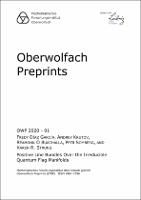| dc.contributor.author | Díaz García, Fredy | |
| dc.contributor.author | Krutov, Andrey | |
| dc.contributor.author | Ó Buachalla, Réamonn | |
| dc.contributor.author | Somberg, Petr | |
| dc.contributor.author | Strung, Karen R. | |
| dc.date.accessioned | 2020-02-11T13:05:21Z | |
| dc.date.available | 2020-02-11T13:05:21Z | |
| dc.date.issued | 2020-02-03 | |
| dc.identifier.uri | http://publications.mfo.de/handle/mfo/3696 | |
| dc.description.abstract | Noncommutative Kähler structures were recently introduced by the third author as a framework for studying noncommutative Kähler geometry on quantum homogeneous spaces. It was subsequently observed that the notion of a positive vector bundle directly generalises to this setting, as does the Kodaira vanishing theorem. In this paper, by restricting to covariant Kähler structures of irreducible type (those having an irreducible space of holomorphic $1$-forms) we provide simple cohomological criteria for positivity, offering a means to avoid explicit curvature calculations. These general results are applied to our motivating family of examples, the irreducible quantum flag manifolds $\mathcal{O}_q(G/L_S)$. Building on the recently established noncommutative Borel-Weil theorem, every covariant line bundle over $\mathcal{O}_q(G/L_S)$ can be identified as positive, negative, or flat, and hence we can conclude that each Kähler structure is of Fano type. Moreover, it proves possible to extend the Borel-Weil theorem for $\mathcal{O}_q(G/L_S)$ to a direct noncommutative generalisation of the classical Bott-Borel-Weil theorem for positive line bundles. | en_US |
| dc.language.iso | en_US | en_US |
| dc.publisher | Mathematisches Forschungsinstitut Oberwolfach | en_US |
| dc.relation.ispartofseries | Oberwolfach Preprints;2020,01 | |
| dc.subject | Quantum groups | en_US |
| dc.subject | Noncommutative geometry | en_US |
| dc.subject | Quantum flag manifolds | en_US |
| dc.subject | Complex geometry | en_US |
| dc.title | Positive Line Bundles Over the Irreducible Quantum Flag Manifolds | en_US |
| dc.type | Preprint | en_US |
| dc.rights.license | Dieses Dokument darf im Rahmen von § 53 UrhG zum eigenen Gebrauch kostenfrei heruntergeladen, gelesen, gespeichert und ausgedruckt, aber nicht im Internet bereitgestellt oder an Außenstehende weitergegeben werden. | de |
| dc.rights.license | This document may be downloaded, read, stored and printed for your own use within the limits of § 53 UrhG but it may not be distributed via the internet or passed on to external parties. | en |
| dc.identifier.doi | 10.14760/OWP-2020-01 | |
| local.scientificprogram | OWLF 2018 | en_US |
| local.series.id | OWP-2020-01 | en_US |
| local.subject.msc | 46 | en_US |
| local.subject.msc | 81 | en_US |
| local.subject.msc | 17 | en_US |
| local.subject.msc | 16 | en_US |
| dc.identifier.urn | urn:nbn:de:101:1-2020042115480308080003 | |
| dc.identifier.ppn | 1691175706 | |

